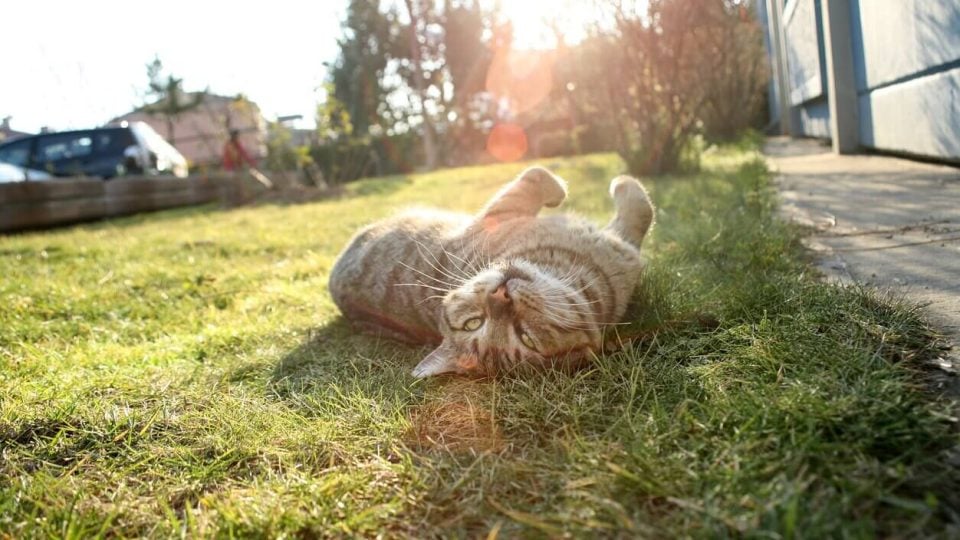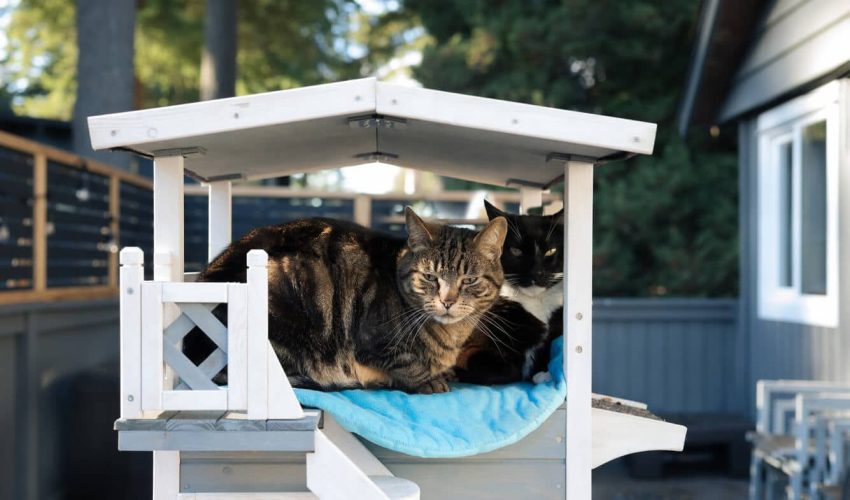Spending a day in the sun generally involves sunscreen, hats, and other strategies to prevent blistering burns—but you may want to take some steps to protect your cat’s skin, too.
“Cats can absolutely get sunburned,” says Patrik Holmboe, DVM, head veterinarian at Cooper Pet Care.
Both indoor and outdoor cats can get sunburned (solar dermatitis), but outdoor cats with limited access to shade are most likely to get skin damage from the sun’s rays. Thankfully, it’s pretty easy to prevent and treat sunburn in cats, and you can start by limiting the time they spend in the sun when it’s most intense.
Below, learn everything you need to know about cat sunburns, including how to tell if your cat has a sunburn and what you can do to prevent it.
Symptoms of Solar Dermatitis in Cats
Sunburn in cats involves many of the same symptoms you might notice after getting scorched, including:
- red, scaly, or thickened skin
- increased scratching at the skin and ears
- bumps, blisters, or lesions
These symptoms can also point to other skin conditions in cats, so it’s always a good idea to speak with your veterinarian if you notice any of these signs.
What do solar dermatitis lesions look like?
Cats who spend a long time in the sun may get a bad case of sunburn that causes more severe symptoms, like lesions.
These can resemble a wound that won’t heal or crusted skin at the nose, ears, eyelids, lips, and other areas at high risk of sunburn, according to Denise Johnson, DVM, CCBC, a cat-friendly veterinarian at IndeVets. “Any suspicious lesions in those areas should be investigated, especially if the area is hairless or the fur is lightly coloured,” Dr Johnson says.
Ongoing exposure to sunlight can cause blistering secondary infections and may lead to tissue death. You can recognise tissue death when areas of skin turn black or brown. These areas may be surrounded by red, swollen skin.
“The more severe the sunburn gets, the higher the chance it requires veterinary attention,” Holmboe says.
Where do solar dermatitis lesions appear?
While cats can get sunburned on any part of their body, the most vulnerable spots for sunburn include:
- ear tips
- edges of the eyes and the eyelids
- nose
- lips
- temples
- areas with short fur, like the belly and inner thighs
- areas and spots with white or light-coloured fur
How does long-term sun exposure affect cats?
“Just like in humans, the real dangers of repeated sun exposure are the possible long-term, carcinogenic effects,” Dr Holmboe says.
Sunburn is skin cell damage caused by excessive exposure to ultraviolet (UV) rays from the sun. Repeated exposure can cause cells to replicate abnormally or not heal as they should. To put it simply, spending a lot of time in the sun can raise your cat’s risk of skin cancer, including squamous cell carcinoma.
This cancer can be deadly, but catching it early can improve treatment outcomes. Pay attention to any small, standalone bumps with hard and irregular borders, especially if the area around the bump is pink and you notice hair loss. This could be a squamous cell carcinoma tumour, so have your vet check it out as soon as possible.
How to Prevent Sunburn in Cats
These six tips can help you keep your cat safe and sunburn-free.
Restrict outdoor time
The most effective way to minimise the risk of harmful sun exposure involves restricting your cat’s outdoor access during peak UV index. Ideally, you’ll want to keep your cat inside from 10am to 4pm, when the sun is strongest.
“Depending on your schedule and your kitty’s, you may need to think creatively to keep them safe,” Dr Johnson says.
Pro tip: The Met Office and other reputable weather apps forecast UV strength. “This allows you to limit exposure on high-risk days and make an informed decision on mild or moderate days,” she explains.
To encourage your cat to come inside, Dr Johnson suggests adding a daily ‘brunch’ snack and installing a smart microchip door to keep them inside during the afternoon.
Appy cat-safe sunscreen
If your cat won’t stay inside, you might choose to apply a pet-safe sunscreen.
However, Dr Johnson says peer-reviewed studies don’t yet support the effectiveness of cat sunscreen for reducing solar dermatitis or lowering the risk of sun cancer.
She also says you should never use human sunscreen for cats, since sunscreen meant for you contains ingredients that can be toxic to your pet, like zinc oxide and salicylates.
Dress your cat in UV-protective clothing
Though it might go without saying, clothing isn’t for every cat. But if your cat will tolerate some clothes, Dr Johnson recommends a shirt that protects against UV rays for time outdoors.
You may also want to consider a shirt for cats who get routine grooming or have just had a procedure that required shaving, as they have an increased risk of sunburn until their fur grows back.
Provide catio access
Catios are outdoor cat enclosures that provide safe outside time.
Spending time in a covered catio—instead of directly under the sun—can provide your cat with mental and physical enrichment while also keeping them safe from the sun’s harmful rays, predators, and cars.
Provide shade and cooling spots
“Cats generally do an excellent job of thermoregulating through location management. They seek heat when they’re too cold and shade when they’re too warm,” Dr Johnson says.
So, offering temperature-controlled spaces can help your cat regulate their body temperature, and they may choose to spend their time outside in the shade. Try setting up a shaded shelter with cool water and a few tiles from the DIY store or a cooling mat to help your kitty stay chill.
Install sun shades
Since most windows don’t block UV rays, indoor cats enjoying a sunny cat nap also have a risk of sunburn. Fortunately, you have affordable options for UV-protective window films to keep sun-loving felines safe.
“As with outdoor kitties, their risk and the time that it takes to develop a sunburn depends on the UV index. With the right UV-blocking film in place or with a low outdoor index, I would not worry about restricting windowsill lounging,” Dr Johnson says.
Which Breeds Are Most Likely to Get Solar Dermatitis?
All cats are vulnerable to sunburn. That said, some cats have a higher risk than others, including:
- Hairless cat breeds, like Sphynx cats
- White cats and cats with white spots
- Light-coloured cats
- Outdoor cats
How to Treat Solar Dermatitis in Cats
Minor feline sunburns may not require medical care. But if skin redness doesn’t improve, your cat seems uncomfortable, or you notice their skin blistering, it’s best to call your vet.
A vet can prescribe soothing topical medications, antimicrobials, anti-inflammatories, or a combination of treatments, Dr Johnson says. She adds that your cat may also need an Elizabethan collar—aka ‘cone of shame’—to prevent them from cleaning off topical products or causing self-trauma during the itchy phase of healing.
Treating acute solar dermatitis in cats
Your vet may prescribe some of the following to treat your cat’s sunburn:
- Pain relief. To help with discomfort, your vet may prescribe short-term pain relief medication. Never give your cat painkillers meant for people.
- Skin treatments. A cool compress can provide relief for sunburned skin, but don’t apply other treatments without first consulting your vet. “At-home treatments may interfere with examination and testing. Even worse, DIY salves or ointments may be ingested and cause more problems,” Dr Johnson says.
- Antibiotics. Call your vet at the first sign of open wounds or blistering. Your cat may need antibiotics to prevent or treat a secondary skin infection.
Treating chronic solar dermatitis in cats:
If your cat has ongoing symptoms of solar dermatitis, your vet may recommend:
- Antibiotics. Chronic sunburn can cause permanent damage to the skin barrier and hair follicles, increasing the risk of secondary skin infections. Your vet may prescribe a long-term antibiotic along with other remedies, like bathing your cat in an antimicrobial solution.
- Anti-inflammatories. Your vet may prescribe these medications to decrease inflammation and soothe your cat’s discomfort.
- Retinoids. Your vet may prescribe retinoids to treat lesions that develop from prolonged sun exposure. Only use medications prescribed by your vet, and never apply retinoids for humans to your cat. Always follow your vet’s instructions carefully to prevent further skin damage, since retinoids can increase the skin’s sensitivity to light.
- Imiquimods. Your vet may prescribe imiquimod cream to treat precancerous or early squamous cell carcinoma lesions.
Cats and Hot Weather, According to Vets
Wondering how to keep your cat safe and cool in warm weather? Our experts have a few more tips.
What counts as ‘too hot’ for cats to be outside?
According to Dr Holmboe, outdoor temperatures of 90°F and above are likely too hot for your cat—and when it’s humid, even lower temperatures can be dangerous for cats.
Panting is a key sign of overheating in cats, Dr. Johnson adds. Heat stroke can be life-threatening, so if you notice your cat panting when it’s hot, move them immediately to a cooler environment. Offer cool water and maybe even a frozen cat treat.
When will the pavement burn my cat’s paws?
“Sidewalks can burn delicate skin of any species,” Dr Johnson says.
You can check the pavement temperature with your hand. If it feels too hot for you to touch for more than a few seconds, then it’s too hot for your cat’s paws!





